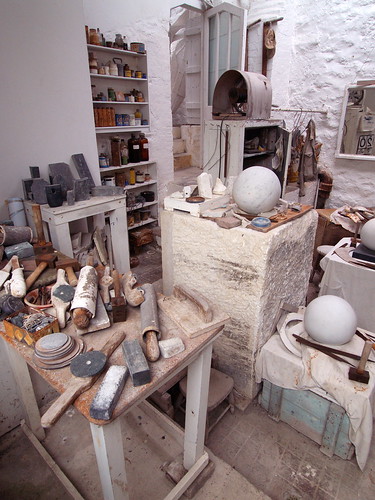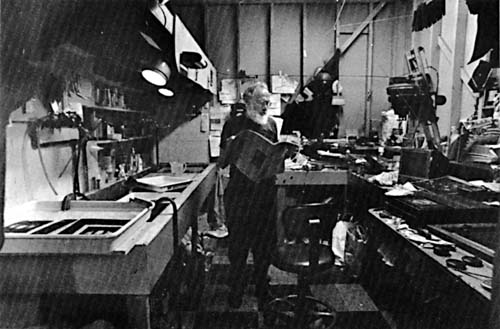Managing a creating environment is something that all creative people do whether they are in fine art to photography, graphics to illustration, game design to animation; we all have a space in which we work. Whilst looking at other artists spaces, they range from being wide open rooms to small desk space to crazy clutter and art materials to minimal and very neat. It is said that creativity is more than your internal thought process, it is what is around you which can help influence you further to bring inspiration and motivation. Also within the collection of materials and items that interest you that can bring further influence to your creative works. Barbra Hepworth – the sculptor – is know for dying and having her study and work studio left exactly as she left it that day. It is inspirational to many because of her object fascination, she has collect hundreds of tools, bottles, shaped objects and they all fit into her work space. What makes this seems workable is the white walls, every wall in her work area is white making all the clutter seem bearable, if you were to work in it. But most of all it is fascinating to many to see how she as an artist worked, what she had around her to inspire her to make her beautiful sculptures. Artists studios are often covered with inspiration and tools where as photographers studios are very minimal and ordered, everything must be right for the perfect picture for the shoot. There is no room for clutter or tools – unless necessary – spaces must be negligible for the subject to really stand out. Darkrooms on the other hand can be as messy as the artist wants for the work has already been put in for the photo, this is the developments and where further inspiration will arise. Looking at my work space in conjunction to others it seems to be cluttered but interspersed with my collecting and what makes me happy – which is what I have been told is what will spur on further inspiration.
Tuesday, 4 October 2011
Lecture 2, ITAP - Development of creative thought and structure in Illustration and Graphic art
After considering the 5 principles portrayed to us on development of creative thought, I decided to explore the 2 principles of: ‘Developing Ideational Fluency’ and ‘Managing a creative environment’. Developing ideational fluency is where we easily produce ideas that fulfill certain requirements but we need to go further. Classification, spider maps, mind mapping and many other tools and examples help us to delve further into our creative mind to generate unique and unusual ideas, that we might not have found if we hadn’t explored all options and dug deeper. Rob Ryan was introduced to us; he is an illustrator who only uses the technique of paper cutting for his works of art. But although he wasn’t the first to create such pieces of art he is know for being unique in the messages and language he portrays within his work. He has to explore different routes and meet the brief but still have his signature look for each piece of work. So when looking into techniques that can create spontaneous thinking to generate more ideas, I looked into the method of Mind Mapping, originally create by Tony Buzan, Mind Mapping is a technique that helps to put ideas from your mind onto to paper in a visual and connecting way. He has a software which can be used on he computer called iMindMap, which is where I decided to draw out my plan for the day and what I needed to get done. As you can see mind mapping uses a main central point to which pictures and then many coloured branches descend from leading on to more smaller branches. This is to depict the idea of memory and the paths that are left when we gain new information. It is a tool that can be used to record your ideas on the go and so you can check them wherever you are an keep up with the amount of ideas. So I looked into how a mind map could help me in the magazine project and how it could gain different ideas for our group and achievement clarity for what we need to do.
Subscribe to:
Post Comments (Atom)







http://www.oocities.org/minoltaphotographyw/williameugenesmith-darkroom-02.jpg
ReplyDeletehttp://farm3.static.flickr.com/2172/2118845766_c4a09c3fd2.jpg
http://www.google.co.uk/imgres?q=photographers+studio&um=1&hl=en&client=safari&sa=N&rls=en&biw=1030&bih=696&tbm=isch&tbnid=1hy1MvJ1hP0UpM:&imgrefurl=http://www.lintonstudios.co.uk/news/commercial-studio-photography/&docid=maEHkfYmveTU8M&w=756&h=462&ei=LCuLTpKRDaia0QWU94XuBQ&zoom=1&iact=rc&dur=579&page=1&tbnh=150&tbnw=209&start=0&ndsp=12&ved=1t:429,r:3,s:0&tx=82&ty=71
www.thinkbuzan.com/iMindMap
http://rob-ryan.blogspot.com/